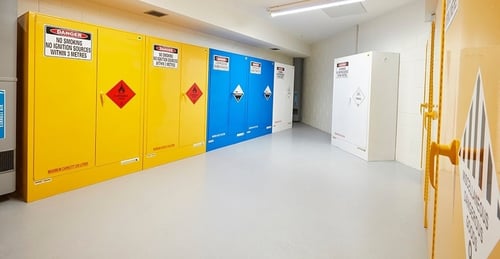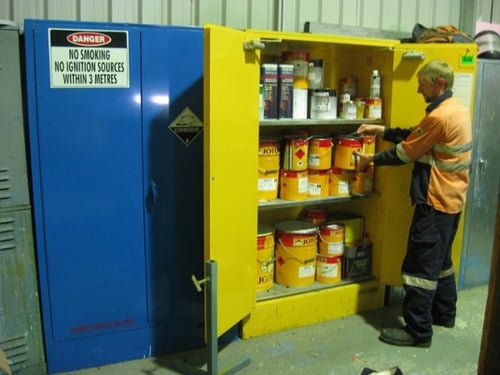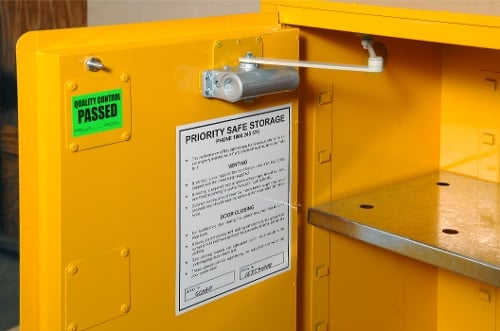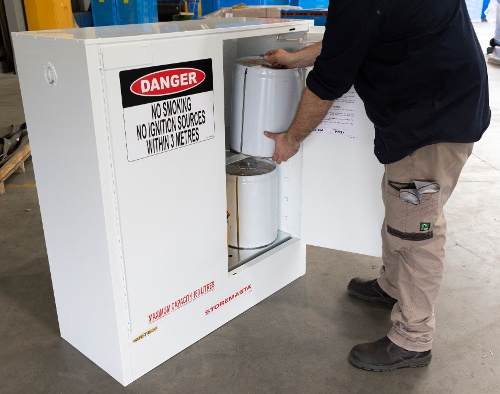Do you have chemical storage cabinets at your site or are you considering purchasing one? This post is focused on helping you improve the lifespan of your chemical storage cabinet through some simple use and maintenance tips. While compliant cabinets are equipped with high-tech chemical controls to minimise hazards for your organisation, regular use and everyday wear and tear can impact the effectiveness of your cabinet. However, there are some things you can do to extend the lifespan of your chemical storage cabinet.
From implementing procedures and inspections to housekeeping and maintenance, here’s some simple ways that you can look after your cabinet, so it keeps working for your business for years and decades to come.
How To Look After Your Chemical Cabinet
Keeping your cabinet compliant is a multi-step process, from choosing the correct model to installing to ensuring that it’s operated and maintained in the right way. When thinking about buying a chemical cabinet for your workplace, you should consider the following points:
- Cabinet Selection – Is the cabinet model and size still suitable for your operations?
- Installation – Have you chosen the right location and followed the correct installation process?
- Operation – How are your staff using the cabinet? Are they using the cabinet in a safe manner?
- Maintenance – Who is responsible for maintaining the cabinet? What set procedures are there for ongoing maintenance or repairs?
- Housekeeping – Is the cabinet regularly cleaned and organised to maintain compliance?
- Inspections – Do you have a set regular schedule to inspect the cabinet and its contents?

Take a multi-tiered approach to looking after your cabinet so you can increase its lifespan and effectiveness.
REMEMBER: Implementing a systematic approach to the use and maintenance of your cabinet will not only help you create a safer workplace, but it will also improve the longevity, durability and effectiveness of your cabinet.
Cabinet Selection
One of the first things to determine is if your cabinet is suitable for the dangerous goods storage needs of your work area. If you have purchased a cabinet that doesn’t still meet your needs, you may be at risk of non-compliance practices as well as damaging the cabinet with improper use.
Consider the following:
- Maximum Capacity Rating - Does the cabinet hold the suitable chemical capacity? Are you overloading shelves or using the spill sump to store your chemicals because you’re running out of room?
- Chemical Class – Are you storing the correct chemical products in your cabinet? Have you checked the Safety Data Sheet for each stored chemical to ensure that it is suitable for your cabinet? Are you mixing chemical classes in the cabinet which can lead to serious safety and compliance issues?
- Cabinet Model – Is your cabinet suitable for the space that it’s kept in. Does it fit the chemical packages that you have onsite or are you having issues with space within the cabinet?
Making sure that your cabinet is suitable for the work area that it’s installed in is an important consideration as the way your staff use the cabinet is affected by the cabinet itself. If your cabinet is too small, the wrong configuration (ie. under bench model Vs upright model) or not suitable for the chemicals that you have onsite, you could be putting the safety of your organisation at risk – as well as damaging your cabinet in the process.

Your cabinet must remain suitable for the type, volume and class of chemicals that you’re storing.
Your cabinet should be able to comfortably fit the chemical packages that you have onsite. It must also be resistant to chemical attack and be able to reduce the risks associated with the specific dangerous goods class that its storing.
If you’re unsure that your cabinet is still appropriate for your needs, speak with a Dangerous Goods Specialist or conduct a risk assessment to determine if changes need to be made.
Installation
While you may have purchased and installed a compliant cabinet many years ago, you need to remember that an incorrect installation can render it unsafe and non-compliant.
Installing your cabinet in the right location — and in the correct manner — will maximise the effectiveness of the equipment as well as extend its lifespan.
Consider the following:
- Is the cabinet installed on a flat, even surface that can hold the weight of the equipment?
- Does your cabinet make it difficult for staff and vehicles to access the work area?
- Could your cabinet become unstable and cause the contents to topple?
- Is there any mezzanine level above the cabinet that could cause impact damage from a fallen object?
- Is there any moisture within your building or roofing issues that could cause the cabinet to corrode?
- Are the adjustable shelves straight and balanced?
- Do the doors close properly and shut automatically?
- Are the doors closing at the appropriate speed or does the closing mechanism require an adjustment?
IMPORTANT: Make sure that fully trained staff, under supervision, are responsible for the installation or relocation of your chemical storage cabinets. You should also refer to the relevant Australian Standard to ensure that all necessary steps are being taken with your cabinet placement and installation.
Operation
While your cabinet is designed to protect your organisation from chemical hazards such as harmful vapours, spillage, and dangerous chemical reactions from incompatible substances, it’s only effective if your staff are using the cabinet in the right way.
One of the biggest problems that we see in workplaces across the country are chemical storage cabinets being used incorrectly by staff. This not only increases the likelihood and impact of a chemical hazard, but it will also degrade your cabinet and render the control measures ineffective and non-compliant.
How your staff use the cabinet in their daily work practices will directly affect how well the cabinet is looked after and maintained.
Think about the following work practices and see if they apply to your staff:
- Have all relevant staff received HAZCHEM training?
- Do all staff working with the cabinet know the features of the cabinet and how to use it?
- Are there procedures and training in place – including refresher training courses?
- Have potential safety issues been addressed and dealt with including the exclusion of workplace ignition sources, the segregation of incompatible substances, protection against impact damage, theft or vandalism?
REMEMBER: If there are new staff, new work procedures or new chemicals onsite, you must review your current dangerous goods storage equipment and procedures to ensure that you are still meeting your compliance obligations. If there are changes in the workplace, you must make sure that no new hazards have been introduced without the correct controls being put in place.
Inspections
Your cabinet inspections will be crucial to the ongoing safety of your equipment. Weekly inspections are the recommended minimum for any business that has a chemical storage cabinet.
You may wish to include the following points in your inspection checklist:
- Are the doors closing properly, automatically and at the right speed?
- Do the cabinet door locks work as they should?
- Are the seals in good condition or do they require replacement?
- Has there been visible damage since the last inspection?
- Are hinges moving freely or do they require lubrication?
- Do all cabinet mechanisms work properly?
- Is the cabinet being used in the appropriate manner?
- Is the surrounding work area free from hazards?
- Does the lighting in the area adequately illuminate the cabinet?
- Does the cabinet display the correct signage?
- Are there any leaks, spills or fumes?
- Are all relevant Safety Data Sheets either attached to the cabinet in a document holder or kept in a visible, static location nearby?
- Is the Register and/or Manifest of Hazardous Chemicals up-to-date?
Housekeeping
One of the most important, yet overlooked, jobs that are associated with dangerous goods storage is the housekeeping of chemical stores. Implementing and maintaining a good housekeeping schedule is vital for the safety and durability of your cabinet.
Consider if the following tasks are being carried out in your work area:
- Is your cabinet regularly checked for chemical leaks and spills?
- Is the spill containment sump free from chemicals and residue?
- Are chemical packages stacked and loaded safely?
- Have packages been stored in the spill sump, in the way of the door closing mechanisms or even on top of the cabinet itself?
- Are there incorrect chemicals or materials stored in, on or near the cabinet?
- Is the cabinet loaded past maximum capacity?
- Are all chemical containers secured with tight-fitting lids?
REMEMBER: We highly recommend a regular housekeeping schedule to maintain the safety of your chemical stores. Create strict procedures and implement training for housekeeping staff, so compliance is maintained in your chemical storage cabinets.
Maintenance
Just like any piece of equipment in the workplace — whether it’s tools, vehicles or dangerous goods storage and handling equipment — your cabinet requires regular attention to ensure it remains in good working order.

Your cabinet should remain in good working order, including the automatic door closing mechanisms.
Maintenance issues may include:
- Dents, scratches or tears visible
- Shelving may be damaged, lugs may be missing
- Doors may not be closing tightly and automatically
- Damage may have occurred to the cabinet or its mechanisms
- There may be signs or corrosion or chemical attack from improper use
- Door seals may need replacing
- Hinges may not be working as they should
- Spill trays may be dented and require replacement
- Safety decals (DG diamond and hazard signage) may be in disrepair
- Maximum capacity rating may not be visible
REMEMBER: You may be able to replace certain cabinet parts if they are showing signs of age or damage. STOREMASTA offers a range of compliant signage and spare parts including shelving, spill trays and door handles.
Keeping Your Cabinet Compliant For Decades To Come
From the moment your cabinet arrives to your site to the last day it’s in operation, it’s important to remember that compliance is an ongoing process. However, with the right procedures and training in place, you can extend the lifespan of your cabinet as well as improve the safety of your operations.
To find out more about safety cabinets, you can access our helpful eBook. Essential Considerations When Storing Flammable Liquids Indoors will help you reduce the risks associated with flammable liquids storage cabinets by providing expert advice on how to correctly select, install, use and maintain your cabinet. Grab your copy for free today by clicking on the image below.
Joining the team as a Dangerous Goods Storage Consultant, Melissa Hampton became Storemasta's Marketing Manager in late 2021. With extensive knowledge and experience in chemical compliance, Melissa is responsible for leading the Marketing team and helping shape their marketing strategy. In her spare time, you can find Melissa hiking, swimming and enjoying the great outdoors in beautiful north-west Tasmania.

